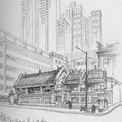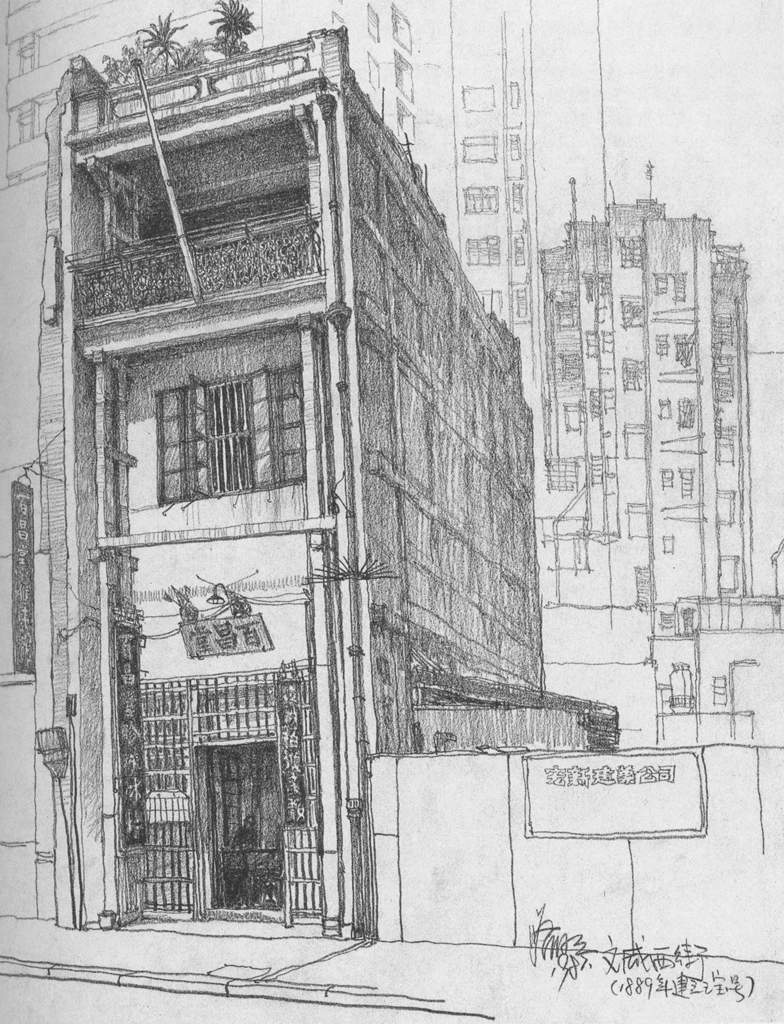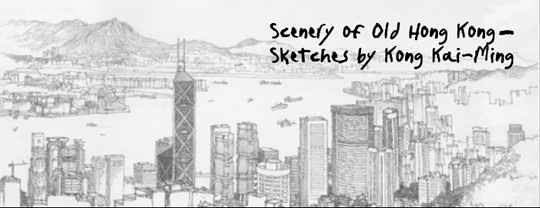Extract from the Guangling San (The Melody of Guangling)
The earliest surviving tablature for the Guangling San is found in the Shenqi Mipu (Mysterious Manuscript) of the Ming Dynasty (1425). There are a total of 45 sections in this piece. Passionate and expressive, this piece tells the story of Niezheng, who committed suicide after assassinating the King of Han to avenge his father during the period of the Warring States. During the Wei and Jin Periods, Ji Kang, a member of the Seven Sages of the Bamboo Grove, offended some dignitaries and was sentenced to death. This piece of music was played before his execution. According to the notes in the Shenqi Mipu, Ji Kang’s Guangling San was a secret piece that was not intended to be passed on to the others, explaining why he sighed with sorrow before his execution, “Guangling San has finally come to its end”.This recorded segment of the qin melody covers the tenth to sixteenth sections of the Guangling San, under the heading Zhengsheng (main body). They are known as Qu Han Diyi (First section: kill the king of the Han), Hu You Di’er (Second section: call for the dead), Wang Shen Disan (Third section: perish), Zuo Qi Disi (Fourth section: courage), Han Zhi Diwu (Fifth section: determination), Chen Si Diliu (Sixth section: sink into thoughts) and Fan Hun Diqi (Seventh section: the spirit returns). This piece of music collected in Favourite Qin pieces of Guan Pinghu was played by Guan Pinghu (1897-1967).
| Date | 1995 |
| People | Guan Pinghu |
| Material Type | Audio |
| Collection | The Legend of Silk and Wood: A Hong Kong Qin Story |
| Source | Courtesy of ROI Productions Limited |
| Repository | Intangible Cultural Heritage Office |
| Note to Copyright | Permission for use in Hong Kong Memory is given by ROI Productions Limited |
| Accession No. | lcs-hkqs-0235 |


Wuye Wu Qiufeng (Parasol Leaves Dancing in the Autumn Breeze)
This piece first appeared in the Qinxue Xinsheng (Study and Aspirations of the Qin) (1664) by Zhuang Zhenfung of the Qing Dynasty and is the most widely played piece among the composer’s fourteen works. It has a delicate melody which evocatively describes the sound of falling leaves in an autumn breeze. In this performance, the piece is played based on Qing Rui's heirloom manuscripts and is played by Yung Hak-chi, Hammond with his own made Keng'er Qin (metal strings).


Yangguan Sandie (Parting at Yangguan)
The earliest version of this piece of qin music appeared in the Zheyin Shizi Qinpu (Qin Songs in Zhejiang Dialect) (1491). The lyrics were developed from a famous poem by the Tang poet, Wang Wei, titled Song Yuan’er Shi Anxi (Seeing Yuan Er Off as Commissioner to Anxi). Many other versions appeared later, but these were either shortened or extended as the arrangers or musicians saw fit. This version is derived from the Yinyinshi Qinpu (Yinyinshi Manuscript) (2000) of Tsar Teh-yun. The music opens slowly, and then accelerates. As the emotions escalate, it changes to rubato before it comes to a more relaxed and muted closing, ending on harmonic notes. The undulating melodic line attempts to recreate the changing emotions of dear friends at parting. This recording is played by Ng Ying-wai with her own made Songtao Qin (synthetic fibre strings).


Pingsha Luoyan (Wild Geese Landing on Sand)
This piece first appeared in a manuscript of the late Ming Dynasty. One of the most widely played pieces of the last three hundred years, it exists in scores of notational versions. The version in the Tianwenge Qinpu (Tianwenge Qin Handbook) (1876) bears a note that suggests programmatic content: “The autumnal sky is high and the air is clear; the wind is calm and the sand is smooth; the clouds stretch for ten thousand miles; the wild geese fly freely in the sky, sharing the thoughts of this wanderer.” This recording is played based on Jiao’an Qinpu (Jiao’an Qin Handbook) (1868) and is played by Siu Yat-tung with his own made Zhongni Style Qin (silk strings).
Extract from the Guangling San (The Melody of Guangling)
The earliest surviving tablature for the Guangling San is found in the Shenqi Mipu (Mysterious Manuscript) of the Ming Dynasty (1425). There are a total of 45 sections in this piece. Passionate and expressive, this piece tells the story of Niezheng, who committed suicide after assassinating the King of Han to avenge his father during the period of the Warring States. During the Wei and Jin Periods, Ji Kang, a member of the Seven Sages of the Bamboo Grove, offended some dignitaries and was sentenced to death. This piece of music was played before his execution. According to the notes in the Shenqi Mipu, Ji Kang’s Guangling San was a secret piece that was not intended to be passed on to the others, explaining why he sighed with sorrow before his execution, “Guangling San has finally come to its end”.This recorded segment of the qin melody covers the tenth to sixteenth sections of the Guangling San, under the heading Zhengsheng (main body). They are known as Qu Han Diyi (First section: kill the king of the Han), Hu You Di’er (Second section: call for the dead), Wang Shen Disan (Third section: perish), Zuo Qi Disi (Fourth section: courage), Han Zhi Diwu (Fifth section: determination), Chen Si Diliu (Sixth section: sink into thoughts) and Fan Hun Diqi (Seventh section: the spirit returns). This piece of music collected in Favourite Qin pieces of Guan Pinghu was played by Guan Pinghu (1897-1967).
| Date | 1995 |
| Material Type | Audio |
| People | Guan Pinghu |
| Collection | The Legend of Silk and Wood: A Hong Kong Qin Story |
| Source | Courtesy of ROI Productions Limited |
| Repository | Intangible Cultural Heritage Office |
| Note to Copyright | Permission for use in Hong Kong Memory is given by ROI Productions Limited |
| Accession No. | lcs-hkqs-0235 |


Wuye Wu Qiufeng (Parasol Leaves Dancing in the Autumn Breeze)
This piece first appeared in the Qinxue Xinsheng (Study and Aspirations of the Qin) (1664) by Zhuang Zhenfung of the Qing Dynasty and is the most widely played piece among the composer’s fourteen works. It has a delicate melody which evocatively describes the sound of falling leaves in an autumn breeze. In this performance, the piece is played based on Qing Rui's heirloom manuscripts and is played by Yung Hak-chi, Hammond with his own made Keng'er Qin (metal strings).


Yangguan Sandie (Parting at Yangguan)
The earliest version of this piece of qin music appeared in the Zheyin Shizi Qinpu (Qin Songs in Zhejiang Dialect) (1491). The lyrics were developed from a famous poem by the Tang poet, Wang Wei, titled Song Yuan’er Shi Anxi (Seeing Yuan Er Off as Commissioner to Anxi). Many other versions appeared later, but these were either shortened or extended as the arrangers or musicians saw fit. This version is derived from the Yinyinshi Qinpu (Yinyinshi Manuscript) (2000) of Tsar Teh-yun. The music opens slowly, and then accelerates. As the emotions escalate, it changes to rubato before it comes to a more relaxed and muted closing, ending on harmonic notes. The undulating melodic line attempts to recreate the changing emotions of dear friends at parting. This recording is played by Ng Ying-wai with her own made Songtao Qin (synthetic fibre strings).


Pingsha Luoyan (Wild Geese Landing on Sand)
This piece first appeared in a manuscript of the late Ming Dynasty. One of the most widely played pieces of the last three hundred years, it exists in scores of notational versions. The version in the Tianwenge Qinpu (Tianwenge Qin Handbook) (1876) bears a note that suggests programmatic content: “The autumnal sky is high and the air is clear; the wind is calm and the sand is smooth; the clouds stretch for ten thousand miles; the wild geese fly freely in the sky, sharing the thoughts of this wanderer.” This recording is played based on Jiao’an Qinpu (Jiao’an Qin Handbook) (1868) and is played by Siu Yat-tung with his own made Zhongni Style Qin (silk strings).
Extract from the Guangling San (The Melody of Guangling)
The earliest surviving tablature for the Guangling San is found in the Shenqi Mipu (Mysterious Manuscript) of the Ming Dynasty (1425). There are a total of 45 sections in this piece. Passionate and expressive, this piece tells the story of Niezheng, who committed suicide after assassinating the King of Han to avenge his father during the period of the Warring States. During the Wei and Jin Periods, Ji Kang, a member of the Seven Sages of the Bamboo Grove, offended some dignitaries and was sentenced to death. This piece of music was played before his execution. According to the notes in the Shenqi Mipu, Ji Kang’s Guangling San was a secret piece that was not intended to be passed on to the others, explaining why he sighed with sorrow before his execution, “Guangling San has finally come to its end”.This recorded segment of the qin melody covers the tenth to sixteenth sections of the Guangling San, under the heading Zhengsheng (main body). They are known as Qu Han Diyi (First section: kill the king of the Han), Hu You Di’er (Second section: call for the dead), Wang Shen Disan (Third section: perish), Zuo Qi Disi (Fourth section: courage), Han Zhi Diwu (Fifth section: determination), Chen Si Diliu (Sixth section: sink into thoughts) and Fan Hun Diqi (Seventh section: the spirit returns). This piece of music collected in Favourite Qin pieces of Guan Pinghu was played by Guan Pinghu (1897-1967).
| Date | 1995 |
| People | Guan Pinghu |
| Material Type | Audio |
| Collection | The Legend of Silk and Wood: A Hong Kong Qin Story |
| Source | Courtesy of ROI Productions Limited |
| Repository | Intangible Cultural Heritage Office |
| Note to Copyright | Permission for use in Hong Kong Memory is given by ROI Productions Limited |
| Accession No. | lcs-hkqs-0235 |


Wuye Wu Qiufeng (Parasol Leaves Dancing in the Autumn Breeze)
This piece first appeared in the Qinxue Xinsheng (Study and Aspirations of the Qin) (1664) by Zhuang Zhenfung of the Qing Dynasty and is the most widely played piece among the composer’s fourteen works. It has a delicate melody which evocatively describes the sound of falling leaves in an autumn breeze. In this performance, the piece is played based on Qing Rui's heirloom manuscripts and is played by Yung Hak-chi, Hammond with his own made Keng'er Qin (metal strings).


Yangguan Sandie (Parting at Yangguan)
The earliest version of this piece of qin music appeared in the Zheyin Shizi Qinpu (Qin Songs in Zhejiang Dialect) (1491). The lyrics were developed from a famous poem by the Tang poet, Wang Wei, titled Song Yuan’er Shi Anxi (Seeing Yuan Er Off as Commissioner to Anxi). Many other versions appeared later, but these were either shortened or extended as the arrangers or musicians saw fit. This version is derived from the Yinyinshi Qinpu (Yinyinshi Manuscript) (2000) of Tsar Teh-yun. The music opens slowly, and then accelerates. As the emotions escalate, it changes to rubato before it comes to a more relaxed and muted closing, ending on harmonic notes. The undulating melodic line attempts to recreate the changing emotions of dear friends at parting. This recording is played by Ng Ying-wai with her own made Songtao Qin (synthetic fibre strings).


Pingsha Luoyan (Wild Geese Landing on Sand)
This piece first appeared in a manuscript of the late Ming Dynasty. One of the most widely played pieces of the last three hundred years, it exists in scores of notational versions. The version in the Tianwenge Qinpu (Tianwenge Qin Handbook) (1876) bears a note that suggests programmatic content: “The autumnal sky is high and the air is clear; the wind is calm and the sand is smooth; the clouds stretch for ten thousand miles; the wild geese fly freely in the sky, sharing the thoughts of this wanderer.” This recording is played based on Jiao’an Qinpu (Jiao’an Qin Handbook) (1868) and is played by Siu Yat-tung with his own made Zhongni Style Qin (silk strings).
Extract from the Guangling San (The Melody of Guangling)
This recorded segment of the qin melody covers the tenth to sixteenth sections of the Guangling San, under the heading Zhengsheng (main body). They are known as Qu Han Diyi (First section: kill the king of the Han), Hu You Di’er (Second section: call for the dead), Wang Shen Disan (Third section: perish), Zuo Qi Disi (Fourth section: courage), Han Zhi Diwu (Fifth section: determination), Chen Si Diliu (Sixth section: sink into thoughts) and Fan Hun Diqi (Seventh section: the spirit returns). This piece of music collected in Favourite Qin pieces of Guan Pinghu was played by Guan Pinghu (1897-1967).
| Interview Date | Date | 1995 |
| People | Guan Pinghu | |
| Material Type | Audio | |
| Collection | The Legend of Silk and Wood: A Hong Kong Qin Story | |
| Source | Courtesy of ROI Productions Limited | |
| Repository | Intangible Cultural Heritage Office | |
| Note to Copyright | Permission for use in Hong Kong Memory is given by ROI Productions Limited | |
| Accession No. | lcs-hkqs-0235 |


Wuye Wu Qiufeng (Parasol Leaves Dancing in the Autumn Breeze)
This piece first appeared in the Qinxue Xinsheng (Study and Aspirations of the Qin) (1664) by Zhuang Zhenfung of the Qing Dynasty and is the most widely played piece among the composer’s fourteen works. It has a delicate melody which evocatively describes the sound of falling leaves in an autumn breeze. In this performance, the piece is played based on Qing Rui's heirloom manuscripts and is played by Yung Hak-chi, Hammond with his own made Keng'er Qin (metal strings).


Yangguan Sandie (Parting at Yangguan)
The earliest version of this piece of qin music appeared in the Zheyin Shizi Qinpu (Qin Songs in Zhejiang Dialect) (1491). The lyrics were developed from a famous poem by the Tang poet, Wang Wei, titled Song Yuan’er Shi Anxi (Seeing Yuan Er Off as Commissioner to Anxi). Many other versions appeared later, but these were either shortened or extended as the arrangers or musicians saw fit. This version is derived from the Yinyinshi Qinpu (Yinyinshi Manuscript) (2000) of Tsar Teh-yun. The music opens slowly, and then accelerates. As the emotions escalate, it changes to rubato before it comes to a more relaxed and muted closing, ending on harmonic notes. The undulating melodic line attempts to recreate the changing emotions of dear friends at parting. This recording is played by Ng Ying-wai with her own made Songtao Qin (synthetic fibre strings).


Pingsha Luoyan (Wild Geese Landing on Sand)
This piece first appeared in a manuscript of the late Ming Dynasty. One of the most widely played pieces of the last three hundred years, it exists in scores of notational versions. The version in the Tianwenge Qinpu (Tianwenge Qin Handbook) (1876) bears a note that suggests programmatic content: “The autumnal sky is high and the air is clear; the wind is calm and the sand is smooth; the clouds stretch for ten thousand miles; the wild geese fly freely in the sky, sharing the thoughts of this wanderer.” This recording is played based on Jiao’an Qinpu (Jiao’an Qin Handbook) (1868) and is played by Siu Yat-tung with his own made Zhongni Style Qin (silk strings).
Extract from the Guangling San (The Melody of Guangling)
The earliest surviving tablature for the Guangling San is found in the Shenqi Mipu (Mysterious Manuscript) of the Ming Dynasty (1425). There are a total of 45 sections in this piece. Passionate and expressive, this piece tells the story of Niezheng, who committed suicide after assassinating the King of Han to avenge his father during the period of the Warring States. During the Wei and Jin Periods, Ji Kang, a member of the Seven Sages of the Bamboo Grove, offended some dignitaries and was sentenced to death. This piece of music was played before his execution. According to the notes in the Shenqi Mipu, Ji Kang’s Guangling San was a secret piece that was not intended to be passed on to the others, explaining why he sighed with sorrow before his execution, “Guangling San has finally come to its end”.This recorded segment of the qin melody covers the tenth to sixteenth sections of the Guangling San, under the heading Zhengsheng (main body). They are known as Qu Han Diyi (First section: kill the king of the Han), Hu You Di’er (Second section: call for the dead), Wang Shen Disan (Third section: perish), Zuo Qi Disi (Fourth section: courage), Han Zhi Diwu (Fifth section: determination), Chen Si Diliu (Sixth section: sink into thoughts) and Fan Hun Diqi (Seventh section: the spirit returns). This piece of music collected in Favourite Qin pieces of Guan Pinghu was played by Guan Pinghu (1897-1967).
| Interviewee | Guan Pinghu |
| Date | 1995 |
| Material Type | Audio |
| Collection | The Legend of Silk and Wood: A Hong Kong Qin Story |
| Source | Courtesy of ROI Productions Limited |
| Repository | Intangible Cultural Heritage Office |
| Note to Copyright | Permission for use in Hong Kong Memory is given by ROI Productions Limited |
| Accession No. | lcs-hkqs-0235 |


Wuye Wu Qiufeng (Parasol Leaves Dancing in the Autumn Breeze)
This piece first appeared in the Qinxue Xinsheng (Study and Aspirations of the Qin) (1664) by Zhuang Zhenfung of the Qing Dynasty and is the most widely played piece among the composer’s fourteen works. It has a delicate melody which evocatively describes the sound of falling leaves in an autumn breeze. In this performance, the piece is played based on Qing Rui's heirloom manuscripts and is played by Yung Hak-chi, Hammond with his own made Keng'er Qin (metal strings).


Yangguan Sandie (Parting at Yangguan)
The earliest version of this piece of qin music appeared in the Zheyin Shizi Qinpu (Qin Songs in Zhejiang Dialect) (1491). The lyrics were developed from a famous poem by the Tang poet, Wang Wei, titled Song Yuan’er Shi Anxi (Seeing Yuan Er Off as Commissioner to Anxi). Many other versions appeared later, but these were either shortened or extended as the arrangers or musicians saw fit. This version is derived from the Yinyinshi Qinpu (Yinyinshi Manuscript) (2000) of Tsar Teh-yun. The music opens slowly, and then accelerates. As the emotions escalate, it changes to rubato before it comes to a more relaxed and muted closing, ending on harmonic notes. The undulating melodic line attempts to recreate the changing emotions of dear friends at parting. This recording is played by Ng Ying-wai with her own made Songtao Qin (synthetic fibre strings).


Pingsha Luoyan (Wild Geese Landing on Sand)
This piece first appeared in a manuscript of the late Ming Dynasty. One of the most widely played pieces of the last three hundred years, it exists in scores of notational versions. The version in the Tianwenge Qinpu (Tianwenge Qin Handbook) (1876) bears a note that suggests programmatic content: “The autumnal sky is high and the air is clear; the wind is calm and the sand is smooth; the clouds stretch for ten thousand miles; the wild geese fly freely in the sky, sharing the thoughts of this wanderer.” This recording is played based on Jiao’an Qinpu (Jiao’an Qin Handbook) (1868) and is played by Siu Yat-tung with his own made Zhongni Style Qin (silk strings).
Extract from the Guangling San (The Melody of Guangling)
The earliest surviving tablature for the Guangling San is found in the Shenqi Mipu (Mysterious Manuscript) of the Ming Dynasty (1425). There are a total of 45 sections in this piece. Passionate and expressive, this piece tells the story of Niezheng, who committed suicide after assassinating the King of Han to avenge his father during the period of the Warring States. During the Wei and Jin Periods, Ji Kang, a member of the Seven Sages of the Bamboo Grove, offended some dignitaries and was sentenced to death. This piece of music was played before his execution. According to the notes in the Shenqi Mipu, Ji Kang’s Guangling San was a secret piece that was not intended to be passed on to the others, explaining why he sighed with sorrow before his execution, “Guangling San has finally come to its end”.This recorded segment of the qin melody covers the tenth to sixteenth sections of the Guangling San, under the heading Zhengsheng (main body). They are known as Qu Han Diyi (First section: kill the king of the Han), Hu You Di’er (Second section: call for the dead), Wang Shen Disan (Third section: perish), Zuo Qi Disi (Fourth section: courage), Han Zhi Diwu (Fifth section: determination), Chen Si Diliu (Sixth section: sink into thoughts) and Fan Hun Diqi (Seventh section: the spirit returns). This piece of music collected in Favourite Qin pieces of Guan Pinghu was played by Guan Pinghu (1897-1967).
| Date | 1995 |
| Material Type | Audio |
| People | Guan Pinghu |
| Source | Courtesy of ROI Productions Limited |
| Repository | Intangible Cultural Heritage Office |
| Note to Copyright | Permission for use in Hong Kong Memory is given by ROI Productions Limited |
| Accession No. | lcs-hkqs-0235 |


Wuye Wu Qiufeng (Parasol Leaves Dancing in the Autumn Breeze)
This piece first appeared in the Qinxue Xinsheng (Study and Aspirations of the Qin) (1664) by Zhuang Zhenfung of the Qing Dynasty and is the most widely played piece among the composer’s fourteen works. It has a delicate melody which evocatively describes the sound of falling leaves in an autumn breeze. In this performance, the piece is played based on Qing Rui's heirloom manuscripts and is played by Yung Hak-chi, Hammond with his own made Keng'er Qin (metal strings).


Yangguan Sandie (Parting at Yangguan)
The earliest version of this piece of qin music appeared in the Zheyin Shizi Qinpu (Qin Songs in Zhejiang Dialect) (1491). The lyrics were developed from a famous poem by the Tang poet, Wang Wei, titled Song Yuan’er Shi Anxi (Seeing Yuan Er Off as Commissioner to Anxi). Many other versions appeared later, but these were either shortened or extended as the arrangers or musicians saw fit. This version is derived from the Yinyinshi Qinpu (Yinyinshi Manuscript) (2000) of Tsar Teh-yun. The music opens slowly, and then accelerates. As the emotions escalate, it changes to rubato before it comes to a more relaxed and muted closing, ending on harmonic notes. The undulating melodic line attempts to recreate the changing emotions of dear friends at parting. This recording is played by Ng Ying-wai with her own made Songtao Qin (synthetic fibre strings).


Pingsha Luoyan (Wild Geese Landing on Sand)
This piece first appeared in a manuscript of the late Ming Dynasty. One of the most widely played pieces of the last three hundred years, it exists in scores of notational versions. The version in the Tianwenge Qinpu (Tianwenge Qin Handbook) (1876) bears a note that suggests programmatic content: “The autumnal sky is high and the air is clear; the wind is calm and the sand is smooth; the clouds stretch for ten thousand miles; the wild geese fly freely in the sky, sharing the thoughts of this wanderer.” This recording is played based on Jiao’an Qinpu (Jiao’an Qin Handbook) (1868) and is played by Siu Yat-tung with his own made Zhongni Style Qin (silk strings).








